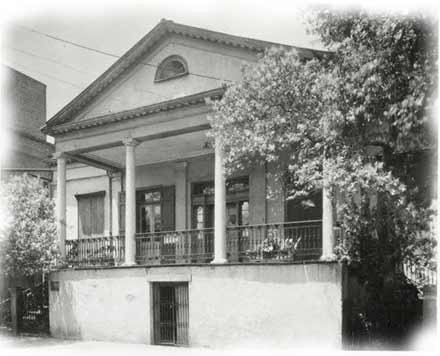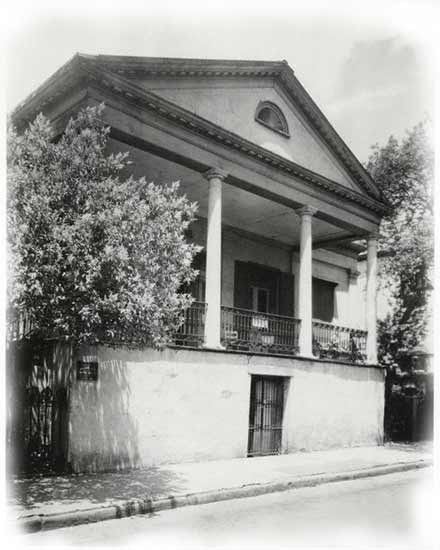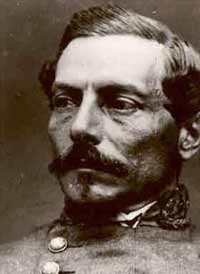Le Vieux Carré et Paul Morphy
Joseph Esau Le Carpentier built his house on 1113 Chartres Street
 This mansion has long been considered one of the most gracious buildings in the French Quarter. All of Alonzo's and Thelcide's children were born in there. Paul Morphy was born June 22, 1837. His brother Edward in 1834, while his sisters, Malvina and Helena were born in 1830 and 1839 respectively. They lived there until 1841 when they moved to 89 Royal Street (later re-numbered to 417 Royal Street).
This mansion has long been considered one of the most gracious buildings in the French Quarter. All of Alonzo's and Thelcide's children were born in there. Paul Morphy was born June 22, 1837. His brother Edward in 1834, while his sisters, Malvina and Helena were born in 1830 and 1839 respectively. They lived there until 1841 when they moved to 89 Royal Street (later re-numbered to 417 Royal Street).John A. Merle, Consul of Switzerland, and his wife, Anais Philippon, purchased the lot beside them from the architect, François Correjolles, and constructed a formal garden there around 1839.
The building itself is an example of a raised, center-hall house, featuring twin curved staircases which lead to a Tuscan portico. The interior boasts a large parlor and ballroom as well as a rectangular dining room leading to a porch.

While it's not certain what became of the Le Carpentiers, Joseph Le Carpentier did purchase the property of 706-708 Barracks Street and 1235-1241 Royal Street in 1841 (the year the Morphy's moved to Royal Street) from Auguste O'Duhig. The house was later purchased by Mme. Josephine Laveau Trudeau (who died Sept. 1, 1849), the widow of a Creole Merchant named Col. Manuel Andry.
The slave revolt of 1811 began on Col. Manuel Andry's plantation on January 8 when a Sainte Domingue slave, named Charles Deslonde led a group of slaves to turn on Andry, wounding him and killing his son, Gilbert. As the word spread, other slaves revolted. 500 slaves were estimated to have taken part in this rebellion. Federal troops quelled the revolt, killing 66 slaves. 27 more were executed, their heads severed and placed on stakes as a warning. Click here for much greater detail.
 It was her estate that rented out the house as a honeymoon cottage for General Pierre Gustave Toutant Beauregard and his second wife,
Marguerite Caroline Deslonde (whose sister, Mathilde, was married to John
Slidell, one time Louisiana senator, one time top Confederate agent in France) . She died in 1864, before the war ended. P.G.T. Beauregard had served with bravery during the Mexican War, had been both an engineer and an artilleryman for the army and had been Superintendent of the Military Academy at West Point before the war. He fired the first shot at Fort Sumter (where his former Artillery instructor, Major Richard Anderson, commanded) and was a hero at First Manassas. But after Albert Johnson was killed at Shilo, leaving Beauregard in charge of a winning battle, only to find the enemy unexpectedly reinforced and attacking in a surprise rout that produced 23,000 casualties, his career suffered greatly. His constant quarrel with Jefferson Davis only exacerbated the situation.
His beloved daughter died in childbirth, followed shortly by the death of his young grandchild. General Beauregard, beaten down by both war and peace, moved in the home at 1113 Chartres Street for 18 months between 1866 to 1868 while he searched for work which he eventually found as president of the New Orleans, Jackson, and Great Northern Railroad, then as as state adjutant general and finally as supervisor of the Louisiana State Lottery. P.G.T. Beauregard, the Great Creole, died in New Orleans on February 20, 1893 and was buried in Metairie Cemetery.
It was her estate that rented out the house as a honeymoon cottage for General Pierre Gustave Toutant Beauregard and his second wife,
Marguerite Caroline Deslonde (whose sister, Mathilde, was married to John
Slidell, one time Louisiana senator, one time top Confederate agent in France) . She died in 1864, before the war ended. P.G.T. Beauregard had served with bravery during the Mexican War, had been both an engineer and an artilleryman for the army and had been Superintendent of the Military Academy at West Point before the war. He fired the first shot at Fort Sumter (where his former Artillery instructor, Major Richard Anderson, commanded) and was a hero at First Manassas. But after Albert Johnson was killed at Shilo, leaving Beauregard in charge of a winning battle, only to find the enemy unexpectedly reinforced and attacking in a surprise rout that produced 23,000 casualties, his career suffered greatly. His constant quarrel with Jefferson Davis only exacerbated the situation.
His beloved daughter died in childbirth, followed shortly by the death of his young grandchild. General Beauregard, beaten down by both war and peace, moved in the home at 1113 Chartres Street for 18 months between 1866 to 1868 while he searched for work which he eventually found as president of the New Orleans, Jackson, and Great Northern Railroad, then as as state adjutant general and finally as supervisor of the Louisiana State Lottery. P.G.T. Beauregard, the Great Creole, died in New Orleans on February 20, 1893 and was buried in Metairie Cemetery. The house that Le Carpentier had built exchanged hands quite a bit and generally went downhill, the way of most other homes in the French Quarter.
New Orleans, like other major cities, has a crime problem. Most of the crime is the usual, garden-variety type. But the Big Easy also has it's share of organized crime. The beginnings of organized crime in New Orleans involves the Le Carpentier house.
The house was purchased in 1909 by the Giacona family. This family was headed by Corrado Giacona, but the house was in Pietro Giacona's name. The family ostensibly posed as wine importers when in fact they were running a wholesale (tax-free) liquor business out of the house on Chartres Street. They were making plenty of money and enjoying a lavish lifestyle. But one evening in 1909 their neighbors reported to the police that they had heard the sounds of an argument and, soon after, the sounds of gunshots. The police investigated and found the results of a killing spree. The story goes that a group, referred to as the Sicilian Black Hand, had been making threats to the Giacona family members, possibly stemming from a territorial dispute. Pietro Giacona had invited them to his house for a dinner party obstensibly to settle the dispute. The Black Hand wanted money for previous infringements and for further protection. Pietro balked at paying this extortion. Rather than capitulate, the Giacona's struck first, killing three and severely wounding the fourth guest. Corrado and Pietro were both arrested and indicted for murder but the charges were dropped (on May 10, 1920). After that incident, though the Giacona family turned the house into a virtual fortress, the Italian community felt more secure. It's said that many wanted to present Corrado and Pietro with medals in appreciation. Although they abandoned the house in the early 1920's, Corrado Giacona remained a powerful force in New Orleans crime until his death in 1944. After his death the power passed first to the Carollo family and then to Carlos Marcello who many feel was involved in the Kennedy assassination.
The Le Carpentier mansion is listed in some New Orleans guidebooks under "haunted house tours". Many people over the years claim to has witnessed apparitions walking along the front gallery. Some claim they are the spirits of soldiers who died at Shilo; others claim they are the spirits of the murdered Giaconas.
In a 1977 interview, Alma H. Neal, the director of the house, denied all of the stories: "We do not know of anything supernatural taking place here."
What else could she say?
In July 1925, the house was purchased at public auction (apparently, the Giacona's didn't bother paying the taxes after abandoning the house) by a man named Antonio Mannino who listed his occupation as "importer" ["importer" was a common mafia occupation title]. While nothing turned up in a search for this particular Antonio Mannino, what did show up was: In 1985 Ignazio Antonio Mannino, commonly known as 'Tony' and his brother, Emanuele Salvatore Mannino, commonly known as 'Sal' were brought to trial as mafia racketeers involved in heroine smuggling.
Antonio Mannino, in a newspaper article on July 16, 1925 threatened to tear down the historic mansion and build a warehouse or a macaroni factory on the lot unless local preservationist could come up with the money necessary to save the house. His plan failed and the house was saved from destruction without paying the extortion money.